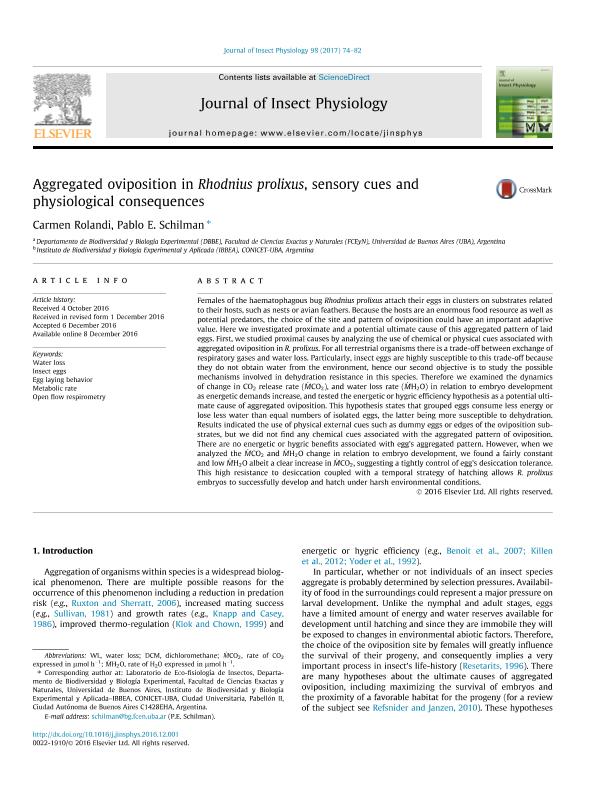Artículo
Aggregated oviposition in Rhodnius prolixus, sensory cues and physiological consequences
Fecha de publicación:
04/2017
Editorial:
Pergamon-Elsevier Science Ltd
Revista:
Journal of Insect Physiology
ISSN:
0022-1910
Idioma:
Inglés
Tipo de recurso:
Artículo publicado
Clasificación temática:
Resumen
Females of the haematophagous bug Rhodnius prolixus attach their eggs in clusters on substrates related to their hosts, such as nests or avian feathers. Because the hosts are an enormous food resource as well as potential predators, the choice of the site and pattern of oviposition could have an important adaptive value. Here we investigated proximate and a potential ultimate cause of this aggregated pattern of laid eggs. First, we studied proximal causes by analyzing the use of chemical or physical cues associated with aggregated oviposition in R. prolixus. For all terrestrial organisms there is a trade-off between exchange of respiratory gases and water loss. Particularly, insect eggs are highly susceptible to this trade-off because they do not obtain water from the environment, hence our second objective is to study the possible mechanisms involved in dehydration resistance in this species. Therefore we examined the dynamics of change in CO2 release rate (ṀCO2), and water loss rate (ṀH2O) in relation to embryo development as energetic demands increase, and tested the energetic or hygric efficiency hypothesis as a potential ultimate cause of aggregated oviposition. This hypothesis states that grouped eggs consume less energy or lose less water than equal numbers of isolated eggs, the latter being more susceptible to dehydration. Results indicated the use of physical external cues such as dummy eggs or edges of the oviposition substrates, but we did not find any chemical cues associated with the aggregated pattern of oviposition. There are no energetic or hygric benefits associated with egg's aggregated pattern. However, when we analyzed the ṀCO2 and ṀH2O change in relation to embryo development, we found a fairly constant and low ṀH2O albeit a clear increase in ṀCO2, suggesting a tightly control of egg's desiccation tolerance. This high resistance to desiccation coupled with a temporal strategy of hatching allows R. prolixus embryos to successfully develop and hatch under harsh environmental conditions.
Archivos asociados
Licencia
Identificadores
Colecciones
Articulos(IBBEA)
Articulos de INSTITUTO DE BIODIVERSIDAD Y BIOLOGIA EXPERIMENTAL Y APLICADA
Articulos de INSTITUTO DE BIODIVERSIDAD Y BIOLOGIA EXPERIMENTAL Y APLICADA
Citación
Rolandi, Carmen; Schilman, Pablo Ernesto; Aggregated oviposition in Rhodnius prolixus, sensory cues and physiological consequences; Pergamon-Elsevier Science Ltd; Journal of Insect Physiology; 98; 4-2017; 74-82
Compartir
Altmétricas




